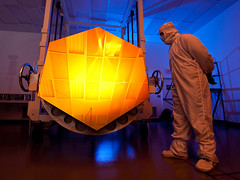Most of today’s telecommunication data is encoded at a speed of 10 Gbit/s, but researchers are constantly looking for new ways to push this limit even further. A group of researchers at Cornell University have recently come up with the “time telescope,” a sophisticated system that can speed up optical communication by 27 times to an outstanding 270 Gbits/s by squeezing more information into a single flash of light and that, unlike previous solutions, does so in an energy-efficient manner.
Pushing the limit beyond 10 Gbps with today’s electronics is proving challenging because engineers have to deal with a series of technological constraints that don’t allow it to deliver much higher frequencies.
Faster transmission speeds can be achieved with optical fiber, but this usually requires a lot of energy because photons, which don’t interact with each other easily, must be “forced” to do so. The team’s work gets around the issue and makes achieving these higher speeds cheaper and much more energy-efficient.
The device developed by the Cornell team is called a “time telescope” and includes two silicon chips called “time lenses” — which work together like the lenses of a normal telescope — lengths of optical fiber and a laser. Because of its small size, it could be used in optical chips inside a computer, as well as for speeding up Internet connections over long distances.










